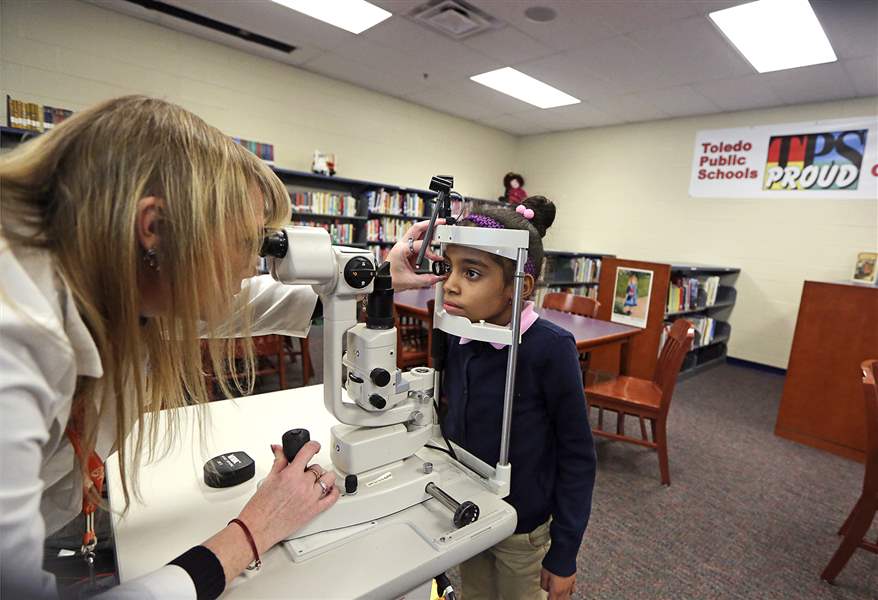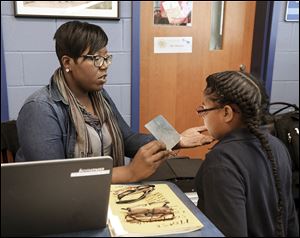
Nurses return to TPS school buildings
District partners with ProMedica for program
3/26/2017
Dr. Donna Baldwin-Mickey examines the eyes of first grader Nakyla Sharpley at Ella P. Stewart Academy.
THE BLADE/JETTA FRASER
Buy This Image
Cindy Muir greeted students by name as she walked down the hallway at Ella P. Stewart Academy for Girls and smiled when they called out “Nurse Cindy.”
Then she spotted a child headed toward her with a nosebleed and quickly ushered the uniformed girl to the school nurse’s office.
From first-aid treatments to giving daily medications and promoting exercise, Mrs. Muir’s work as a registered nurse stationed full-time at the central city elementary school keeps her connected to students and their health-care needs.

‘Nurse Cindy’ Muir chats with kindergartner Amazing Peterson at the elementary school.
Toledo Public Schools recently hit the midway point of a three-year partnership with ProMedica that placed school nurses in each elementary building.
School district and health system officials are praising the project for improving students’ access to health care, including vision and dental services, and nearly doubling the number of nurse visits made by elementary age children during the first year.
“Just being able to be here every day has helped us just to really work and focus on these kids more than ever before,” Mrs. Muir said.
She is one of a dozen nurses hired by the district in 2015 under the public-private financial partnership that officials said is the only one of its kind in Ohio.
ProMedica’s strategy
A $600,000 annual ProMedica donation covers the cost for nine of those nurses through the 2017-2018 school year. TPS pays for the others.
The additional positions bring the total number of TPS nurses to 51 — enough for each elementary and traditional high school to have at least one.
Before the expansion, Stewart and other elementary schools shared nurses who covered two or three buildings, leaving sites without a full-time nurse.
“Those nurses are incredibly valuable for the kids and families at TPS. They really are a go-to person for kids who maybe have a chronic disease or have some sort of challenge on a regular basis,” said Stephanie Cihon, who works in ProMedica’s community relations and advocacy department.
The effort fits into ProMedica’s strategy to address social determinants of health, she said.
The health system has not announced if or how it will continue to fund the project beyond its initial three-year scope, but Ms. Cihon said a decision could be made before the end of next school year.
TPS now has one nurse for every 440 elementary students, better than the ratio of one nurse for every 750 students recommended by the National Association of School Nurses.

Optician Kristin Moncrief, left, holds a mirror for Ny’Asia Morris, 8, as the second grader selects frames. The district reported a rise in the number of students receiving eye exams in the program’s first year, from 1,005 students to 1,044 last year.
The estimated statewide ratio for private and public schools is one full-time registered nurse for every 1,268 students, according to the most-recent available data from the Ohio Department of Health.
Only a quarter of registered nurses surveyed by the state in 2010 were assigned to a single school building. More than half served three or more sites.
In 2015-2016, the Toledo program’s first year, students in 40 elementary schools made 138,651 nurse visits, up from 72,247 the year before. The number of treatments provided by nurses — including administering medication, first aid, and mental-health support — increased by 87 percent, the district reported.
Asthma, serious food or bee sting allergies, Type 1 diabetes, and seizure disorders are the most commonly diagnosed chronic illnesses affecting Toledo elementary students. More than a third of the district’s 13,991 elementary students have been diagnosed with at least one of those illnesses, and 652 children have three or more chronic health conditions.
The number of chronic cases inched up in recent years, though health officials struggle to explain exactly why. They point to yet-to-be discovered environmental issues, food-related triggers, and obesity rates as among likely factors.
TPS intends to collect data showing how nurses affect attendance rates and academic performance of students, but health services coordinator Ann Cipriani said the project is still too new to measure significant changes.
In 2004, researchers studying TPS students with asthma found that those who attended a school with a full-time nurse missed an average of 23 percent fewer days than asthmatic students at schools with a part-time nurse.
Nurses help students stay in class, said Kelly Burkholder-Allen, interim director of health services for the Toledo-Lucas County Health Department. It has a contract with Sylvania schools to provide five nurses in that district.
“Every tummy ache isn’t the same,” she said. “Sometimes little people have difficulty knowing their bodies and understanding what some of the issues are.”
Eyes on reading
TPS elementary school nurses have been asked to form advisory committees to identify areas to improve health in their buildings. As a result, several schools launched physical activity clubs to get children moving and rev up their brains, Ms. Cipriani said.
The district also hopes that having nurses in each elementary school will increase the number of students who participate in mobile vision and dental clinics offered by the local health department.
Mrs. Muir said she consulted with teachers to identify students who might need glasses or struggled with reading. Then she kept sending notes home and calling parents to make sure she received the necessary permissions to have the children examined when an optometrist visited the school last week.
As a result of that follow-through, more Stewart academy girls are receiving eye care. The number of eye exams increased from 24 children in 2015 to about 45 this year.
Across the district, TPS reported the number of students receiving eye exams increased modestly in the first year of the expanded nurse program, from 1,005 students to 1,044 last year.
“We are making a difference already. These kids are getting care they’ve never gotten before,” Mrs. Muir said.
Donna Baldwin-Mickey spent about 20 minutes with each Stewart student who received a comprehensive eye exam on a recent school day.
Part of the school library transformed into a makeshift optometrist office, and Dr. Baldwin-Mickey clicked through large and small letters displayed on a screen to test students’ vision. She also checked for glaucoma and conducted an internal eye exam.
When she examined Ny’Asia Morris, the doctor determined the second grader needed glasses. The 8-year-old said she couldn’t see all the letters during her vision test. She likes to read, especially the Diary of a Wimpy Kid book series, and said she plans to wear her new glasses every day.
Ny’Asia picked out a pink pair — one of her favorite colors — and she’ll get her new specs in about a month. The health department handles insurance and billing.
Ms. Cipriani said access to care has a direct affect on students’ health and how they perform in school.
“It’s a very easy jump to see if you can’t see, you can’t read,” she said.
Contact Vanessa McCray at: vmccray@theblade.com or 419-724-6065, or on Twitter @vanmccray.